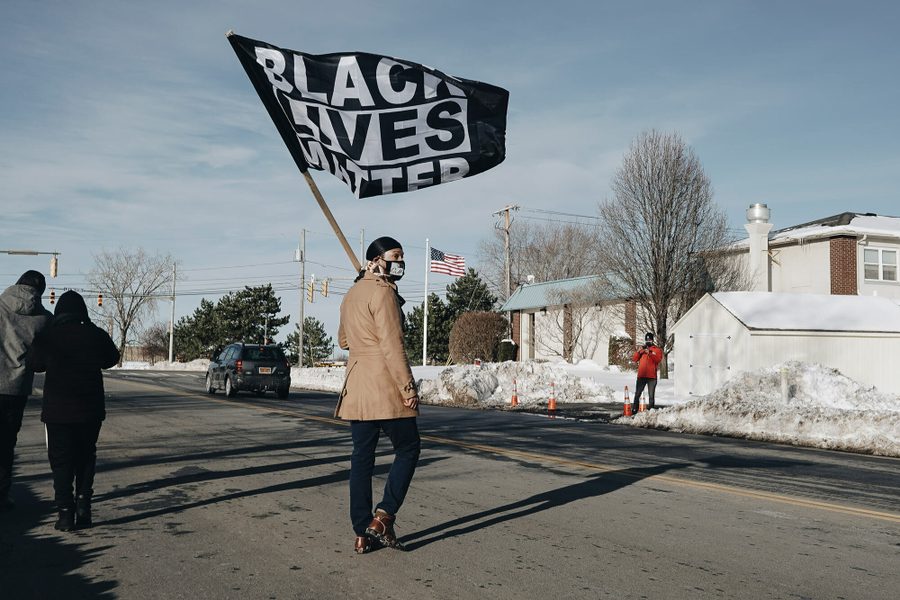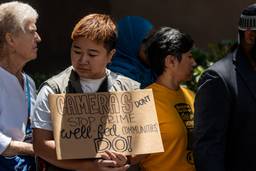In Rochester, A Police Alternative Delivers ... Police
Activists were excited about the launch of a new Person in Crisis team in a city that’s suffered a string of police violence incidents—but so far, it’s fallen short on its promises.
Sam Mellins

ROCHESTER , N.Y. — On January 21, city officials launched a new Person in Crisis (PIC) team of 14 mental health professionals and social workers to provide non-police responses to behavioral health crises. Eight days later, the Rochester Police Department (RPD) arrested and pepper-sprayed a 9-year-old in crisis. Videos show the girl crying out for her father. “Please don’t do this to me,” the girl says. “You did it to yourself, hon,” an officer replies.
Then, on February 22, Rochester officers tackled and pepper-sprayed a woman with her 3-year-old after she allegedly shoplifted. On March 10, Rochester police shot and killed Tyshon Jones, 29, who was threatening to hurt himself with a knife outside a homeless shelter, reports say.
All three individuals in these police encounters were Black.
“That these incidents occurred after the PIC team was announced demonstrates that the team is either underfunded and therefore ill-equipped, or intentionally toothless and ill-conceived,” says Stanley Martin, an organizer with Free the People Rochester, a Black liberation group. The PIC team was not called in any of these incidents, according to Martin.
While activists were initially hopeful that the PIC program would prevent police violence, they say that it has been unreliable in practice, in part because of strict criteria limiting who it can assist. Individuals under the influence of substances — often the people who most require behavioral health intervention — have been unable to access PIC aid.
Rochester has been the site of large — and ongoing — Movement for Black Lives protests since Daniel Prude, 41, was killed by the RPD in March of 2020 while undergoing what his family’s lawyer called a “psychotic episode.” Prude’s brother had initially called 911 seeking help.
One of Rochester protesters’ primary demands was investment in police alternatives that would treat people in mental health crises “with respect and dignity, and also utilize some of the trainings like unconditional positive regard that mental health therapists are grounded in,” Martin says.
The PIC program is a direct response to these demands.
In a statement announcing PIC’s launch, Rochester Mayor Lovely Warren said it would “revamp … the way we respond to non-violent crises” and “ensure that those in crisis receive treatment rather than punishment.” Activists who pushed for the PIC team were particularly excited about its source of funding: $350,000 of the $650,000 budget comes from a contingency fund the city created by cutting the RPD’s recruit class in half. The program operates under the purview of the Department of Recreation and Human Services (DRHS), not the police department.
Residents are supposed to be able to get immediate support from social workers and mental health counselors by calling 211, a crisis line operated by a local Goodwill, rather than 911.
But those who have tried calling 211 say PIC rarely shows up. Elora Kang, a resident of Rochester’s Corn Hill neighborhood, says she was “elated” about the launch and watched the press conference live, hopeful the team could help people struggling to access mental healthcare. But a recent experience has deflated her enthusiasm.
On January 28, Kang called 211 to help a friend and neighbor in crisis, but no PIC agents were available after 45 minutes. Soon, another neighbor called the police; seven officers arrived in minutes.
Kelly Ann Sciarratta, who works at a Rochester detox center, has had similar experiences. She says the PIC idea “sounds like a dream,” but so far, the program has fallen short. Sciarratta has called for crisis response aid more than three times from her workplace. Police were dispatched twice. The PIC team wasn’t sent at all.
“Police are still responding to mental health calls, police are still responding to issues of substance use disorder in our community,” Martin says.
While 211 is the publicized PIC number, 911 is the line that actually dispatches PIC workers. Some of the early mishaps may be due, in part, to a lack of clarity from city government about the PIC team’s jurisdiction and the relationship between 911 and 211.
Residents and organizers also worry the program’s strict eligibility criteria could prevent people who need care from getting it. Individuals who are under the influence of drugs or alcohol have been told they are ineligible for PIC assistance.
“They need to change those harsh stipulations,” Kang says. “That’s the whole point of a mental health crisis [response team]. You need to think of the demographic of folks that you are trying to help.”
Similar police alter native efforts elsewhere have proven more effective. In Eugene, Ore., for example, the Crisis Assistance Helping Out on the Streets (CAHOOTS) program is the default response to nonviolent behavioral health and substance abuse crises. In 2019, CAHOOTS teams, each made up of a medic and a crisis worker trained in de-escalation, responded to 24,000 calls — about 20% of all 911 calls in the area. Fewer than 1% of calls to CA HOOTS required police assistance.
PIC is now in a 180-day pilot phase, which administrators say will likely extend to permanent implementation. RPD and DRHS did not respond to requests for comment.
Despite initial disappointment, Martin isn’t giving up. “We do see hope on the horizon,” Martin says. “With adequate funding and adequate resources, the [PIC] program could be successful.”
SAM MELLINS is an NYC-based journalist and associate editor of New York Focus.





